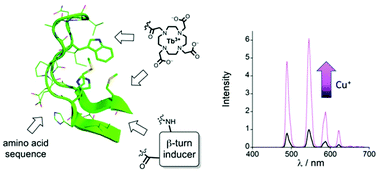当前位置:
X-MOL 学术
›
Org. Biomol. Chem.
›
论文详情
Our official English website, www.x-mol.net, welcomes your
feedback! (Note: you will need to create a separate account there.)
Influence of amino acid sequence in a peptidic Cu+-responsive luminescent probe inspired by the copper chaperone CusF†
Organic & Biomolecular Chemistry ( IF 2.9 ) Pub Date : 2018-07-20 00:00:00 , DOI: 10.1039/c8ob01044g A. Roux 1, 2, 3, 4, 5 , M. Isaac 1, 2, 3, 4, 5 , V. Chabert 1, 2, 3, 4, 5 , S. A. Denisov 2, 6, 7, 8, 9 , N. D. McClenaghan 2, 6, 7, 8, 9 , O. Sénèque 1, 2, 3, 4, 5
Organic & Biomolecular Chemistry ( IF 2.9 ) Pub Date : 2018-07-20 00:00:00 , DOI: 10.1039/c8ob01044g A. Roux 1, 2, 3, 4, 5 , M. Isaac 1, 2, 3, 4, 5 , V. Chabert 1, 2, 3, 4, 5 , S. A. Denisov 2, 6, 7, 8, 9 , N. D. McClenaghan 2, 6, 7, 8, 9 , O. Sénèque 1, 2, 3, 4, 5
Affiliation

|
Copper(I) is a soft metal ion that plays an essential role in living organisms and Cu+-responsive probes are required to detect Cu+ ions in physiological conditions and understand its homeostasis as well as the diseases associated with its misregulation. In this article, we describe a series of cyclic peptides, which are structurally related to the copper chaperone CusF, and that behave as Cu+-repsonsive probes. These peptide probes comprise the 16-amino acid loop of CusF cyclized by a β-turn inducer dipeptide and functionalized by a Tb3+ complex for its luminescence properties. The mechanism of luminescence enhancement relies on the modulation of the antenna effect between a tryptophan residue and the Tb3+ ion within the probe when Cu+ forms a cation–π interaction with the tryptophan. Here, we investigate the influence of the amino acid sequence of these cyclic peptides on the copper-induced modulation of Tb3+ emission and show that the rigid β-turn inducer Aib-D-Pro and insertion of the Tb3+ complex close to its tryptophan antenna are required to obtain turn-on Cu+ responsive probes. We also show that the amino acid sequence, especially the number and position of proline residues has a significant impact on metal-induced luminescence enhancement and metal-binding constant of the probes.
中文翻译:

铜伴侣CusF †激发 的肽性Cu +响应发光探针中氨基酸序列的影响
铜(I)是一种软金属离子,在活生物体中起着至关重要的作用,需要使用Cu +响应探针在生理条件下检测Cu +离子并了解其稳态以及与其失调相关的疾病。在本文中,我们描述了一系列环状肽,这些环状肽在结构上与铜分子伴侣CusF有关,并且表现为Cu + -探针。这些肽探针包含一个由CusF的16个氨基酸组成的环,该环被β转角诱导剂二肽环化,并被Tb 3+复合物官能化,从而具有发光特性。发光增强的机制依赖于色氨酸残基和Tb之间的天线效应的调节当Cu +与色氨酸形成阳离子-π相互作用时,探针中的3+离子。在这里,我们研究了这些环状肽的氨基酸序列对铜诱导的Tb 3+发射的调节的影响,并表明刚性β-转角诱导剂Aib- D -Pro和Tb 3+复合物的插入接近需要使用其色氨酸天线才能获得开启的Cu +响应探针。我们还表明,氨基酸序列,尤其是脯氨酸残基的数量和位置,对金属诱导的发光增强和探针的金属结合常数具有重大影响。
更新日期:2018-07-20
中文翻译:

铜伴侣CusF †激发 的肽性Cu +响应发光探针中氨基酸序列的影响
铜(I)是一种软金属离子,在活生物体中起着至关重要的作用,需要使用Cu +响应探针在生理条件下检测Cu +离子并了解其稳态以及与其失调相关的疾病。在本文中,我们描述了一系列环状肽,这些环状肽在结构上与铜分子伴侣CusF有关,并且表现为Cu + -探针。这些肽探针包含一个由CusF的16个氨基酸组成的环,该环被β转角诱导剂二肽环化,并被Tb 3+复合物官能化,从而具有发光特性。发光增强的机制依赖于色氨酸残基和Tb之间的天线效应的调节当Cu +与色氨酸形成阳离子-π相互作用时,探针中的3+离子。在这里,我们研究了这些环状肽的氨基酸序列对铜诱导的Tb 3+发射的调节的影响,并表明刚性β-转角诱导剂Aib- D -Pro和Tb 3+复合物的插入接近需要使用其色氨酸天线才能获得开启的Cu +响应探针。我们还表明,氨基酸序列,尤其是脯氨酸残基的数量和位置,对金属诱导的发光增强和探针的金属结合常数具有重大影响。











































 京公网安备 11010802027423号
京公网安备 11010802027423号